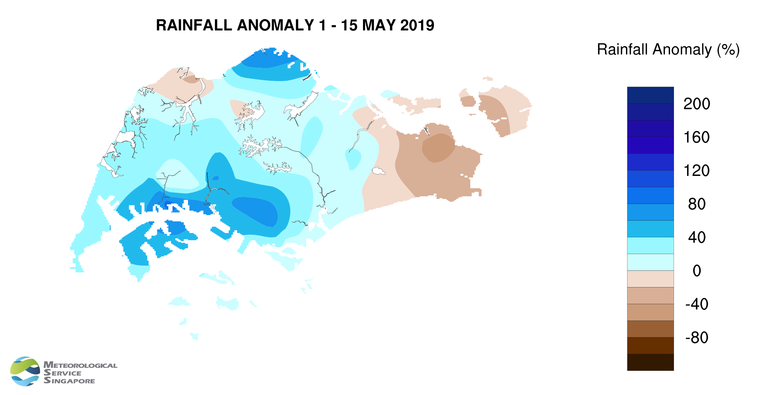Fortnightly Weather Outlook for 16 – 31 May 2019
Singapore, 16 May 2019 – Inter-monsoon conditions that started in late March 2019 are expected to continue for the rest of May 2019. During this period, the low level winds are forecast to blow from the south or southeast.
2 In the second fortnight of May 2019, short-duration thundery showers are expected mostly between the late morning and early afternoon on six to eight days. On two to three days in particular in the first week of the coming fortnight, the occurrence of Sumatra squalls is forecast to bring widespread thundery showers accompanied by gusty winds between the predawn and morning. Overall, the rainfall for May 2019 is likely to be above-normal for many parts of Singapore.
3 The warm and humid conditions experienced during the first half of May 2019 are forecast to continue for the rest of May 2019. The daily temperature on most days is expected to range between 26°C and 34°C, and on days with little or no rainfall, the daily maximum temperature could reach around 35°C.
4 For updates of the daily weather forecast, please visit our MSS website (https://www.weather.gov.sg), NEA website (www.nea.gov.sg), or download the myENV app, or the MSS’ Weather@SG app.
REVIEW (1 – 15 May 2019)
5 Inter-monsoon conditions prevailed over Singapore and the surrounding region in the first half of May 2019. The low level winds during the period were generally weak and variable in direction.
6 During the fortnight, the presence of the monsoon rain band near the equatorial region brought short-duration thundery showers over the island, mostly between the morning and early afternoon. On a few of these days, the stormy weather was a result of the eastward passage of Sumatra squalls which brought widespread thunderstorms and gusty winds over Singapore between the predawn hours and morning. As a result of strong convergence of air streams in the region, two consecutive Sumatra squalls moved across Singapore on 8 May 2019 – one during the early hours and predawn, and another in the late morning. On that day, the highest daily total rainfall of 109.8 mm was recorded at Jurong West. Sumatra squalls moved across the island again on 10 and 11 May 2019. Gusty winds with speed up to 90km/h was recorded at Pasir Panjang on 10 May 2019, and a large waterspout was sighted over the sea area south of Tanjong Pagar on 11 May 2019.
7 Despite the wet weather in the first fortnight of May 2019, most days recorded maximum temperatures of 34.0°C or more. The highest daily maximum temperature of 35.0°C was recorded at Paya Lebar and Clementi on 6 and 7 May 2019 respectively. The lowest daily minimum temperature of 20.8°C was recorded at East Coast Park around predawn when the squall moved over Singapore on the 8 May 2019.
8 More than three quarters of Singapore received above average rainfall in the first fortnight of May 2019. Rainfall was lowest over the eastern part of Singapore at Changi where 40.2 mm (49% below average) of rain was recorded. The highest rainfall of 194.4 mm (89% above average) was recorded at Jurong.
CLIMATE STATION STATISTICS
Long-term Statistics for May
(Climatological reference period: 1981 – 2010)
| Average daily maximum temperature | 32.2 °C |
| Average daily minimum temperature | 25.4 °C |
| Average monthly temperature | 28.3 °C |
| Average rainfall | 171.2 mm |
| Average number of rain days | 14 |
Historical Extremes for May
(Rainfall since 1869 and temperature since 1929)
| Highest monthly mean daily maximum temperature: | 33.6 °C (1997) |
| Lowest monthly mean daily minimum temperature: | 23.5 °C (1974) |
| Highest monthly rainfall ever recorded: | 386.6 mm (1892) |
| Lowest monthly rainfall ever recorded: | 41.6 mm (1997) |

